









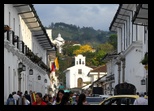


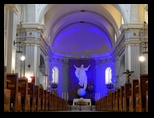
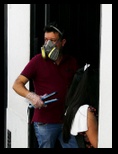
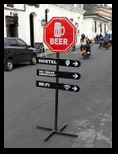

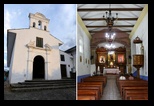



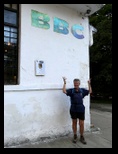



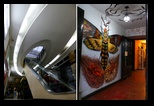
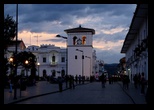



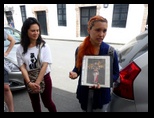
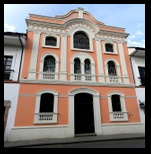

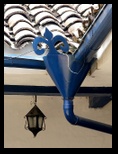




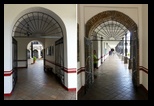
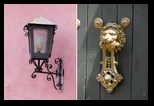
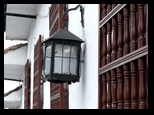




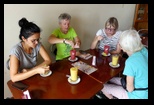


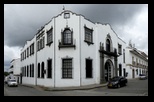

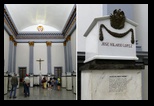
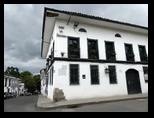

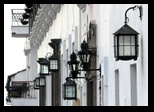
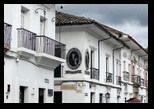




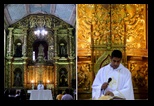
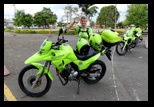



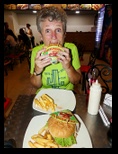
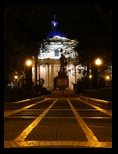
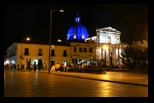
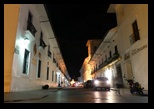

Click on a photo to enlarge it.
31.01.2020: Remolino nach Popayán
We didn't get much sleep because of the heat and a cat jumped on our roof at 8am, so we gave up and just got up.
The first 15km of road were quite bad as we headed further north. Our first stop was a place we'd found on iOverlander. One of the entries said "Holy Shit, the view!" which was exactly how we referred to it - that was how we put it into our GPS aswell!! So, of course we had to take a look. Unfortunately it was very hazy when we got there so it wasn't as spectacular as some of the views we'd already seen. After the obligatory photos we continued on a very windy road and through what we thought would be a small town but was extremely busy and crowded. Must be market day.
We stopped for a coffee break at the Parador of the singing frog. (Yes, that was it's name!) But we neither saw nor heard any frogs ... it was toadally quiet. (Sorry, couldn't resist that one).
We headed into Popayán, one of the highlights for Colombia. It is a beautiful colonial town with narrow streets. It was almost 5pm by the time we got there so we drove straight to a parking garage and agreed a price of $9 US for 2 nights and had until 5pm on Sunday. There is a guard on duty so we could leave our motor home there safely whilst we wandered around the town.
At least it was cooler and we enjoyed wandering around for almost 2 hours, visiting various churches - San Jose, San Francisco and the cathedral. The oldest, Ermita de Jesús de Nazareno, was built in 1534 and smelled distinctly of mold! We looked at a bridge that has 12 arches and went for a really good Italian for pasta gorgonzola and tried out a local fruit juice called Lulo. It's a kind of passion fruit. The restaurant had good WiFi so I tried to watch the UK leaving the EU ... live ... but just at that moment some guitarists came in to serenade the guests and I missed it!!! Oh well, at least we could send out some WhatsApps and check some of the football results.
01.02.2020: Popayán
When we arrived at the main square we couldn't see any group waiting or someone who looked like a guide holding up an umbrella maybe. So we wandered around the square and after about 10 minutes noticed a group forming in front of the cathedral. There were 6 or 7 French, 2 Canadians, an American, a South Tyrolean, and a Colombian with her Dutch friend.
A short time later, Daniela, our tour guide, arrived. She introduced herself briefly in English. She is in her mid-twenties, with orange stripes in her braided hair, a tattoo behind her ear and one on her wrist. She studied microbiology in Popayán and she also speaks German because she worked as an au pair in Nuremberg for a year. We liked her right from the start.
A second tour guide arrived and took the French tourists whilst we stayed for the English version. Daniela started our tour with the words "I hope you will fall in love with Popayán again and again by the end of the tour. And bring your friends next time!" Then we all introduced ourselves briefly and off we went.
Daniela told us that Popayán is also called the "White City". A long time ago a plague caused by nigua (chigoe flea or jigger) broke out. These small insects laid their eggs in people's toenails which caused painful blisters and swelling. As most people were very poor at the time they did not wear shoes. So Popayán's streets and house walls were sprinkled with lime to prevent the plague from spreading. So the whole city was turned white.
Today it is compulsory to paint the houses in the historic city centre white. There are only five exceptions: 1. La Casa Rosa (literally the pink house) where Francisco José de Caldas lived, which is ... you guessed it ... pink; 2. The pantheon is blue-gray - Popayán's most important citizens are buried here; 3. The theater is green; 4. and 5, the San Francisco church and courthouse are painted yellow.
Our first stop was the cathedral. Daniela showed us photos of the really bad earthquake in 1983. During the Easter week there was a large service in the cathedral with hundreds of pilgrims. Shortly after 9am there was a 6.8 magnitude earthquake. Many of the people sought refuge under the dome - thinking it was safer there but the earthquake was too strong for the dome to sustain, and it collapsed. Although it lasted less than half a minute, damage to property was extensive and 267 people were killed (25% of them in the cathedral) and a further 7,500 people were injured. In total 14,000 buildings were damaged, the majority of them in the city's historic centre. 6,885 of them suffered damage greater than 50% to the structure and a further 4,500 minor damage. 2,470 houses collapsed.
Despite this disaster the Easter processions, for which Popayán received the UNESCO World Heritage Award in 2009, continued. The cathedral was then completely rebuilt. Pope John Paul II visited the ruins of Popayán in 1986 and - although still completely destroyed - the cathedral was given the status of a basilica.
The first church on this site in Popayán dates back to the 16th century. Daniela tells us the story of the loss of the Corona de los Andes - a 22 carat gold crown with 450 emeralds which, according to legend, was worn by the Inca King Atahualpa who ruled from 1497 to 1533. This crown was put on the head of the Virgin Mary statue during Easter week and was otherwise under lock and key.
The crown disappeared around 1936 and decades later it was found out that the wealthy Popayán family, who oversaw this crown, had applied to the Pope in Rome for the crown to be sold in order to fund orphans and poor people in Popayán. It took years to find a buyer but the crown was eventually sold in 1936. The orphanage and poor house were never built - the family simply stole the money.
Daniela asked the group "Where do you think the crown is today?" Of course, Kirsten was the first to open her mouth and shouted "United States!" In a very deep and resigned voice Daniela said "Exactly!" In 2015 the Metropolitan Museum in New York acquired the crown, which is on display. Daniela told us that Colombia would like this crown back, but the cost of it exceeds Colombia's total current debt to the United States.
Then Daniela made us laugh. With a sly smile she says that that wasn't the only crown the Colombians lost. In 2015, Miss Universe was crowned in Las Vegas (again the USA !!!!). The moderator of the election announced that Miss Colombia had won and Miss Colombia was crowned. Five minutes later they announced an error had been made and declared Miss Philippine the winner!! Embarrassing! Colombia was not amused!
We continued the tour along Calle 5. There are 5 historic and very beautiful churches along this street. We visited one of the old, colonial houses with its inner courtyards. Today, the Easter Processions Foundation is located in these buildings and we are shown some pictures. The Easter processions actually originated in Seville, Spain and we saw some fantastic processions in Antigua, Guatemala a few years ago. But Popayán is the only city in the world that has been declared a UNESCO World Heritage Site for their processions.
Across from the colonial house is Casa Rosa and Daniela tells us about one of the city's most important men - Francisco José de Caldas. Next is the Santo Domingo church. The fountain here originally stood in the central square in front of the cathedral, but later had to give way to the monument to Francisco José de Caldas, after which the square is named today.
Colombia is world famous for its coffee production and Daniela shows us a small café where you can try the local types of coffee. You can also try the same coffee here with different brewing techniques - it should taste different each time, even though it is the same coffee bean. Popayán is also world famous for its gastronomy and has a UNESCO World Culture Award for it. There are two very typical drinks here that already looked very tasty in Daniela's pictures!
We continued to the famous city bridge - the Puente Del Humilladero. This 240m-long, 12-arch brick bridge was constructed in the mid-19th century to improve access to the centre from the poor northern suburbs. It dwarfs the adjacent Puente de la Custodia, a pretty stone bridge constructed in 1713 to allow priests to cross the Río Molino to bring the holy orders to the sick. Daniela told us the main bridge survived the 1983 earthquake but is being damaged by music festivals that take place there every weekend!!
From the bridge you have a good view of the El Morro de Tulcán - an Indigenous pyramid. Research suggests that the individuals buried here came from the very top of the social classes of their society. The pyramid was constructed in the pre-Columbian period, approximately between 1600 - 500 BC. On the top, a statue dedicated to the Conquistador Sebastián de Belalcázar stood here from 1937 until 2020.
Daniela gave us some insight into the situation in Colombia at the moment. Despite the peace treaty with the FARC that was signed 3 years ago, there is still no total peace in the country. It is a long-term process that is not stable. 23 "social leaders" who have campaigned for the rights of the country's indigenous and poor have been murdered in recent months (probably by the government and the police although you will never find out the exact details).
To date, the government has kept very few promises from the peace treaty and the unrest is growing in the country. A few months ago the FARC threatened to end the negotiated peace treaty because the government failed to keep its promises. Another Colombian on our tour with her visiting Dutch friend added, in perfect English, how two of the remaining indigenous tribes in Colombia are campaigning for their land rights. There are many social construction sites in Colombia and unfortunately also a lot of corruption. The rich society here has everything in their hands and is trying to stay in power. Daniela doesn't want to scare us, but says we should be vigilant. It's not all as great as we might see or read in the media.
Our tour ended after 2.5 hours and was really very interesting. Daniela was excellent and she got a lot of tips from everyone.
Together with Angelika (South Tyrol), Karen (Vancouver Island) and Judy (USA) we walk straight to the Mora de Castilla restaurant, a tip from Daniela, and order everything that Daniela recommended! We ordered two types of drinks - Champus, made from lulo (a local fruit), corn, pineapple and panela which is the raw form of sugar; and Salpicón payanés, made from blackberries, lulo and guyabano, another local fruit known as soursop in English. It looks like a Durian fruit but is green and spiky on the outside but white with lots of pips on the inside.
We also ordered the Empanadas de Pipián and the Tamales Pipián. They are made from potatoes, peanuts and achiote (a type of paprika). We had read the word Empanadas de Pipián all over the city yesterday and wondered what they were, so now we could find out! It all tasted so good we ordered extras!!! 5 women from 5 different countries all having a great time! A fitting end to a superb tour.
After picking up some supplies and having coffee in our motorhome we walked back into town, seeing it with new eyes. We made a detour towards the bus terminal and walked over one of the bridges. However, outside the historic city centre, Popayán looked quite different. The streets were a bit run down, dubious people sat around on the streets, and there were far more police. We decided to take the next bridge back to the centre!
In the evening, the many street lamps cast a soft light on the white house facades - very photogenic! We went to a restaurant for a burger with fries and saw on TV that the new corona virus had already reached Colombia. In Cali, 1200 Chinese people were involved in building roads and the company was being closed down and the people put in quarantine. None of this was being reported in the international media. Oh, oh ... and we're heading to Cali in the next few days for repairs!
02.02.2020: Popayán
The next day we used some of the solar power to write on the computer and also send WhatsApps. We paid 28000 (approx. $9) for 48 hours of parking and drove to a Jumbo supermarket to do our shopping. We hit traffic on our way out of Popayán so we parked up at a petrol station about 15km north. We had to put up with loud music but at least it was switched off at 11pm! They only switched it off because they closed the petrol station for the night. Hmmm!! But we decided to stay and we were perfectly safe.
Tour in Popayán. Great market in Silvia. Bird paradise Finca Finca Alejandría.